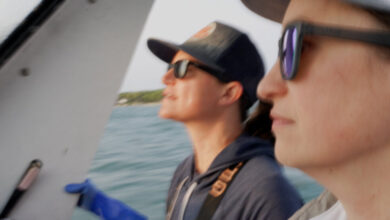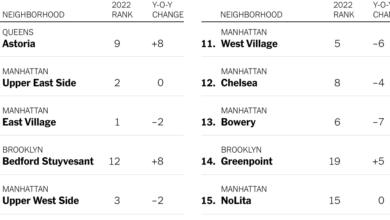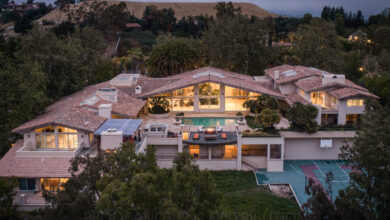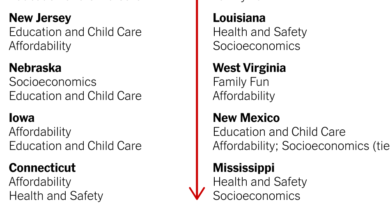Lacey Township, N.J.: A Waterfront Community With a Working-Class Vibe
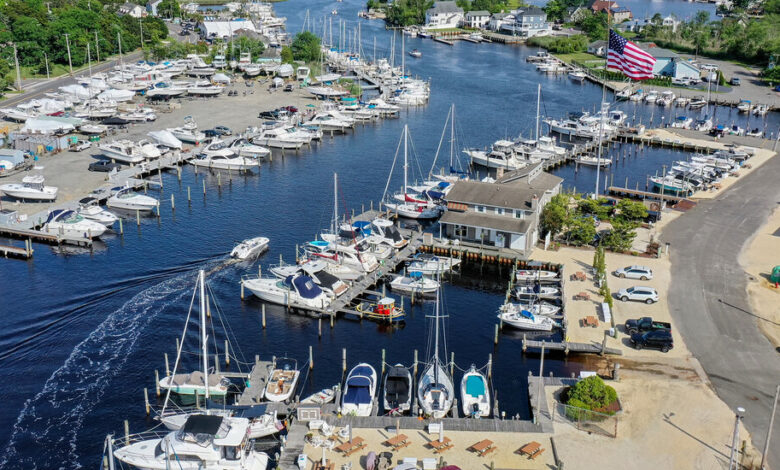
[ad_1]
As he opened up the throttle of his new 23-foot motorboat, Casey Quinn boasted that he could get from the dock at the back of his house in Forked River, N.J., to the Barnegat Inlet in less than 18 minutes. A heavy chop on the bay, and a less than seaworthy passenger, forced him to slow down a bit, so the trip out to the Atlantic Ocean took about 20 minutes instead.
Ready waterway access is a primary draw for this Ocean County waterfront — but not beachfront — community. Also, it is separated from the Atlantic coast beaches by the bay, so housing prices are substantially less than those in areas fronting the ocean.
Defined by the three branches of the Forked (pronounced FORK-id) River, and the numerous channels off those branches, the Forked River area of Lacey Township is paradise for boaters, those who like to fish or clam, and anyone who gravitates toward the water.
“It’s on the map now,” said Mr. Quinn, 29, a real estate investor and sales agent whose grandfather came here in the 1960s. “I see the population changing, and it’s a little bittersweet. But you can’t blame anyone. It’s really everything you want, at an affordable price.”
When they decided to blend their Howell, N.J., households this spring, Angela Viviani and Robert Chambers were thrilled to discover that they could afford a waterfront home large enough to accommodate seven children in Lanoka Harbor, another community in Lacey Township. In April, they closed on a 3,000-square-foot house with five bedrooms and a loft, with a cash offer of $665,000 that was $20,000 above asking price.
“It’s just so beautiful and relaxing,” said Ms. Viviani, the marketing director for an independent living facility. “When you go to bed at night, you see the lights on the water, and the stars. I’ve never been so at peace and happy.”
Thomas Zemaneck, an avid fisherman, discovered the area two years ago while looking for a summer getaway from his home in Montville, N.J., about 100 miles north. He found a three-bedroom ranch house with a dock in Forked River, which he bought for $337,000. Most weekends, he and his son, Thomas Jr., take one of their boats out to the ocean to catch tuna, striped bass and even shark.
“I come down on a Friday night, and I can be out on the ocean early Saturday morning,” said Mr. Zemaneck, 63, a crane operator in New York City. “Everybody’s so nice and down to earth here. It’s like a working-class town, with a real homey feel.”
While there are million-dollar-plus homes facing Barnegat Bay, farther inland there are much more modest bungalows and ranch houses, and many now serve as homeowners’ primary residences. Jeff Connell, a real estate broker with Coldwell Banker, said that when he first came to Lacey Township as a child, about 20 percent of the population lived there year-round. Now, he estimated, it’s about 60 percent.
“At that time, the only way to make a living here was out on the bay, or in the woods,” said Mr. Connell, 64, referring to the fishing and hunting that shaped life in the township before expanded roadways brought commuters from North Jersey and New York City, and before the 1969 opening of the Oyster Creek nuclear power plant brought thousands more to the area. The cooling tower at the south end of Forked River is a physical landmark, but the nuclear reactor was shut down in 2018 and is in the process of being decommissioned.
“Now you’ve got people who come here to retire, plus families and working people — nurses and mechanics,” Mr. Connell said. “It’s an inexpensive place to live, with a lot of people who are just normal.”
What You’ll Find
Covering nearly 100 square miles (more than 82 of them land), Lacey Township comprises three communities: Forked River, where three quarters of the township’s 28,000 residents live, said Veronica Laureigh, the township administrator; Lanoka Harbor, another bay-front area north of Forked River, where 20 percent of the population lives; and Bamber Lake, in the Pine Barrens, where fewer than 1,000 people live. Almost two-thirds of the township is in the protected Pinelands, and most of the residential neighborhoods are east of the Garden State Parkway.
The north, middle and south branches of the Forked River and numerous tributaries provide ample opportunities to own waterfront homes, from elevated shoreline colonials built after Hurricane Sandy to the few remaining fishing shacks built by the developer Charles Pearl in the mid-20th century.
A different type of waterfront living can be found in the neighborhoods that surround the three Cedar Lakes west of Route 9, where houses are more modest and residents can walk to the freshwater beaches to swim or fish.
Running north to south, Route 9 serves as the commercial corridor of Lacey Township, with big-box stores and supermarkets at the northern end and diners, nurseries and ice cream shops farther south on the two-lane road. Most of the marinas lie along the northern and southern banks of Forked River’s north fork, which is also where some of the township’s best preserved Victorian homes are.
Three new townhouse complexes at the north end of Route 9, in various stages of development, will add about 400 new units in the next few years, said Ms. Laureigh, 54, a lifelong resident.
“I’d like to think of us as the sleepy little town we once were,” she added, “but we haven’t been that in eons.”
What You’ll Pay
As in so many suburban communities, the housing market in Lacey Township has heated up considerably since the pandemic struck. In early June, there were 88 homes on the market, 21 of them in contract. The most expensive was a five-bedroom waterfront house built in 1998 in Forked River, with an in-ground pool, listed for $1.6 million; the least expensive was a gutted two-bedroom house built in 1955 in Lanoka Harbor, listed for $150,000.
The average sale price through June 1 of this year was $342,045, up from $257,500 during the same period a year ago, according to the Monmouth Ocean Multiple Listing Service. Inventory is moving quickly, with the average days on the market shrinking from 52 last June to just 13 days currently.
Although the 800-acre nuclear power station has been shut down, the state still pays significant taxes to the township, reducing residential property taxes by about a third compared with those in neighboring towns, Ms. Laureigh said.
The Vibe
Whether it’s fishing in the bay or swimming in the lakes, an appreciation of water is nearly a prerequisite to living in Lacey. Much of the activity starts at one of the marinas along the north fork, where some spend the weekend aboard their boats, even if they live in town.
The next stop is Tices Shoals, a low-water sandbar in Barnegat Bay, just off the inland coast of Island Beach State Park. On a sunny Saturday, hundreds of boats drop anchor there for a floating party, with walkable access to the ocean beaches. By the end of the day, many end up at Captain’s Inn and Tiki Bar, a sprawling waterfront restaurant and bar that occupies both sides of East Lacey Road; if you’re lucky, you can pull into one of the restaurant’s 25 slips.
The lifeguard-protected Cedar Lake beaches are popular, and residents can buy a seasonal beach pass for just $5. A new floating playground with slides and obstacle courses on Lake Barnegat, called the Wibit, can be enjoyed for a separate fee.
The township offers swimming lessons, summer day camp and other recreational programs at its many parks. Landlubbers have several alternatives, from hiking trails in the Pine Barrens to the 7.6-mile Barnegat Branch Trail for biking and hiking along abandoned railroad lines.
The Schools
Lacey Township’s public school system has four elementary schools, three of which go up to fourth grade; the fourth, Mill Pond Elementary, in Lanoka Harbor, includes fifth and sixth grades. Students in seventh and eighth grades attend Lacey Township Middle School, which enrolls about 670 students, then continue on to Lacey Township High School, which has about 1,130 students in ninth through 12th grades.
In 2019-20, the average SAT scores at Lacey Township High School were 545 in reading and writing and 534 in math, compared with state averages of 536 in each. High school students can participate in the College Academy, where they can take up to 64 credits of college-level courses at Ocean County College and earn an associate degree while in high school.
Private school options, which are limited, include St. Joseph Grade School, a Roman Catholic school in neighboring Toms River, and Lighthouse Christian Academy, in Manahawkin. Both serve students in prekindergarten through eighth grade.
The Commute
Lacey Township is about 80 miles south of New York City. The drive takes about 90 minutes, depending on traffic.
The only public transportation option is the bus, which takes about two hours and 20 minutes. The trip starts at Route 9 and Lacey Road, on New Jersey Transit’s No. 559 line, and runs to Toms River, where riders transfer to the 319 or 137 line and continue on to Port Authority. The one-way fare is $22.75; a monthly pass is $496.
The History
The Forked River State Game Farm was New Jersey’s first state-run game farm, on property just off Route 9 that the state’s fish and game commission acquired in 1912 from a former master of a sailing freighter. Every year, the farm would raise and release thousands of pheasants to be hunted by sportsmen and women who visited the farm. In later years, the game farm’s management sought the assistance of residents of the neighboring juvenile rehabilitation center. The game farm is now part of the Edwin B. Forsythe National Wildlife Refuge.
For weekly email updates on residential real estate news, sign up here. Follow us on Twitter: @nytrealestate.
[ad_2]
Source link



